
The Bottom Line
Introduction
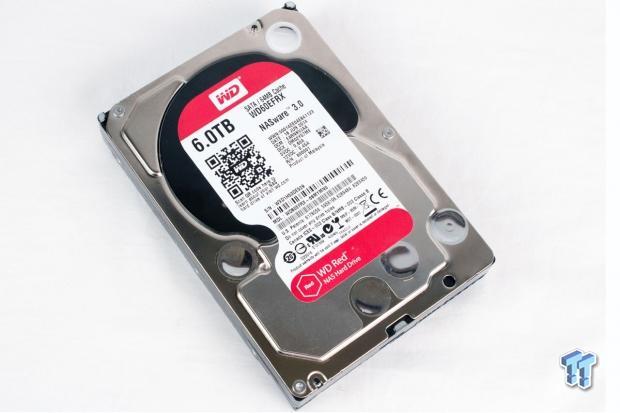
The enhancements in NASware 3.0 allow the new line of WD Red NAS HDDs to scale up from one to five bay applications to eight bays. This extends the reach of the primarily client-oriented Red drives into SOHO applications. The Red now also encroaches partially upon the WD SE's territory. The WD SE is geared specifically for the datacenter, and addresses similar workloads of up to 180 TB/year, in six to twelve bay NAS applications. WD also released the WD Red Pro (reviewed here) for larger eight to sixteen bay applications.
The features that make the Red attractive to NAS users also provide benefits in DAS RAID usage. One of the biggest challenges for professional users is to find value HDDs that are acceptable for RAID usage. Desktop drives suffer from numerous disadvantages when paired with onboard RAID, or even full-featured RAID controllers.
One of the keys for reliable RAID data storage is the ability to communicate HDD data errors to the controller. This prevents the drive itself from spending a lengthy time attempting to repair the error, which results in the RAID array dropping the entire drive from the array. Large capacity drives triggering an entire RAID rebuild process invoke a lengthy performance crippling process that places users in danger of losing all of their data in the event of an unrecoverable error. NAS drives avoid this process by communicating the error to the RAID code, which in turn rebuilds the affected data from parity.

The new series of Red drives also expands capacity to 5TB and 6TB in the 3.5" form factor, and smaller capacity 2.5" form factor drives are available. This increases capacity up to 48TB for eight-drive RAID, or NAS applications. The 6TB Red features a 175 MB/s SDR (Sustained Data Rate) and 64 MB of cache. The SDR varies upon capacity, and all drives feature the SATA 6Gb/s connection.
The Red spins at 5,400 RPM, or Intellipower as WD refers to it, which reduces power consumption and noise. The WD Red Pro is designed for heavier workloads, and spins at 7,200 RPM. The 6TB Red also features a 10^14 UBER rating and one-million hour MTBF, which is on par for NAS HDDs. All the NAS drives in our test pool are rated for 600,000 load/unload cycles.
Initial revisions of the drive featured a firmware bug that slowed performance in heavy random workloads, but WD quickly issued a firmware fix for affected customers, and all drives currently shipping have the new firmware already installed.
NASware 3.0 improves resistance to vibration through a software implementation that detects vibration via head movements, and 3D Active Balance Plus dual-plane balance control steadies the platters during operation. The Red also improves reliability by completing all commands in process during a power loss event. WD has certified the Red series with a broad range of NAS manufacturers to ensure widespread compatibility.
The Red series offers a three-year warranty, and a 24/7 premium support phone line for users. The increased capacity and NASware 3.0 features make the Red a great choice for DAS RAID environments, and today we are testing the Red against the previous generation Red, and other RAID/NAS offerings. First, let's take a closer look at the hardware.
PRICING: You can find the WD Red Enterprise HDD for sale below. The prices listed are valid at the time of writing, but can change at any time. Click the link to see the very latest pricing for the best deal.
United States: The WD Red 6TB retails for $292.00 at Amazon, the WD Red 5TB retails for $244.00 at Amazon, the WD Red 4TB retails for $169.00 at Amazon, the WD Red 3TB retails for $121.99 at Amazon, the WD Red 2TB retails for $98.00 at Amazon, and the WD Red 1TB retails for $65.29 at Amazon.
Canada: The WD Red 6TB retails for CDN$375.48 at Amazon Canada, the WD Red 5TB retails for CDN$312.37 at Amazon Canada, the WD Red 4TB retails for CDN$203.16 at Amazon Canada, the WD Red 3TB retails for CDN$139.98 at Amazon Canada, the WD Red 2TB retails for CDN$119.99 at Amazon Canada, and the WD Red 1TB retails for CDN$74.98 at Amazon Canada.
WD Red Internals and Specifications
WD Red Internals
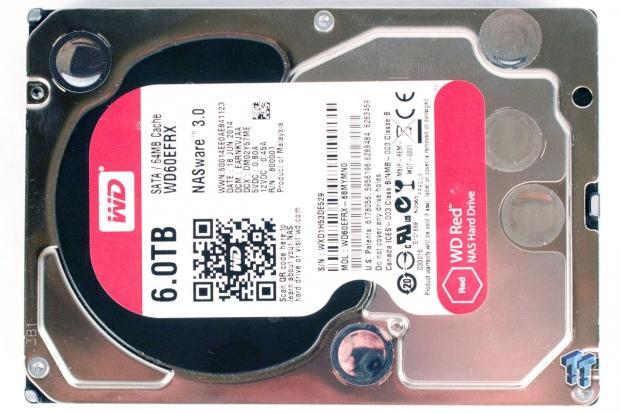
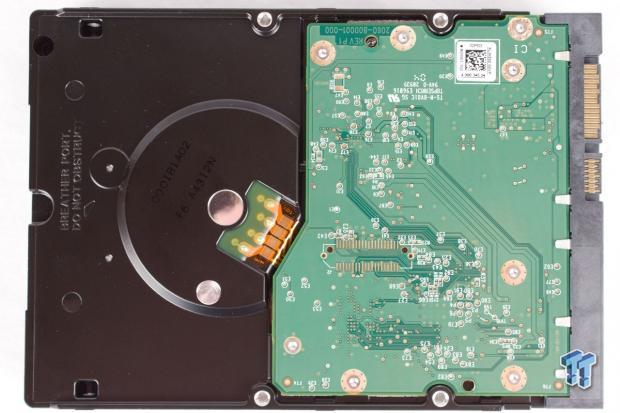
The WD Red comes in both 2.5" and 3.5" form factors; however, there is a reduction in capacity on 2.5" models. The breather port on the bottom of the drive indicates this is a standard air-filled HDD. The 6TB WD Red utilizes five platters with PMR technology.
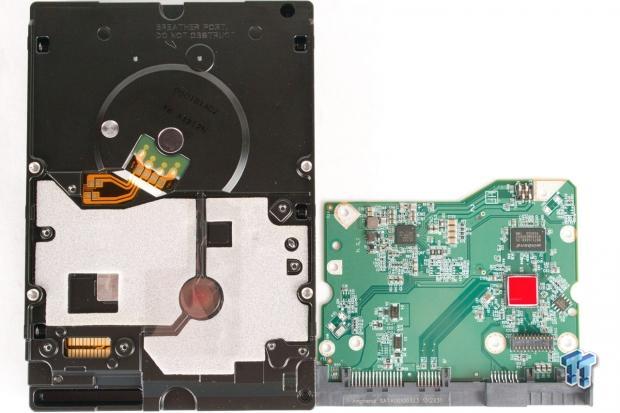
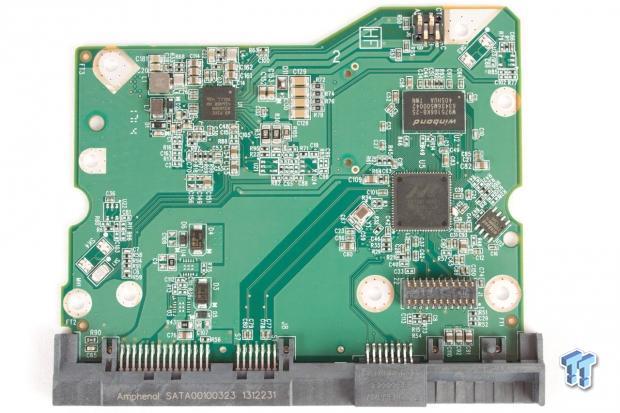
A foam pad between the case and the PCB helps absorb vibration, and the controller has a thermal pad that sheds heat into the case of the drive. There are angled mounting pads open for accelerometers on the upper right and lower left of the PCB. These pads are empty because the Red uses software-based vibration detection. Advances in NASware 3.0 allow the Red to be placed into eight bay NAS systems. The WD PIKE motor controller is in the middle upper left of the PCB.
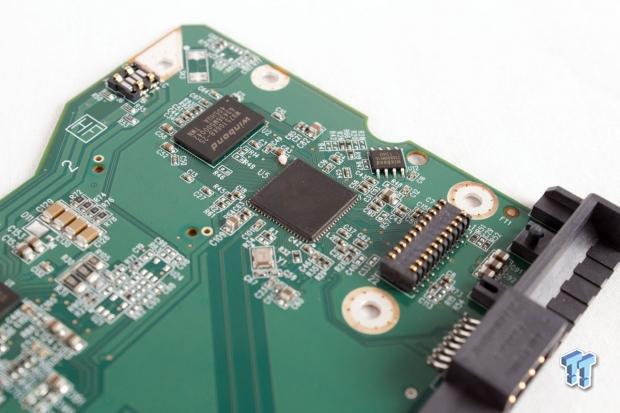
The Marvell controller is flanked by a 64MB multi-segmented cache package.
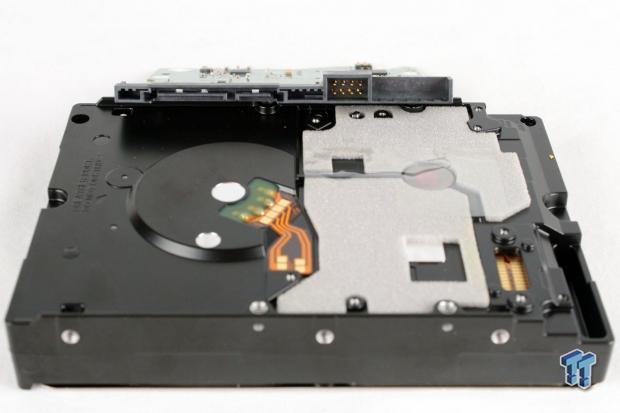
The WD Red features a standard 6Gb/s SATA port that allows use in the majority of one to eight bay NAS systems.
WD Red Specifications
The WD Red Pro features Advanced Format, Streaming Support, SMART Command Transport (SCT) for monitoring, and power management support. All data flushes to the platters in the event of power loss. The Red Pro is available in 1TB to 6TB capacities with the WD10EFRX, WD20EFRX, WD30EFRX, WD40EFRX, WD50EFRX, and WD60EFRX part numbers, respectively.


Test System and Methodology
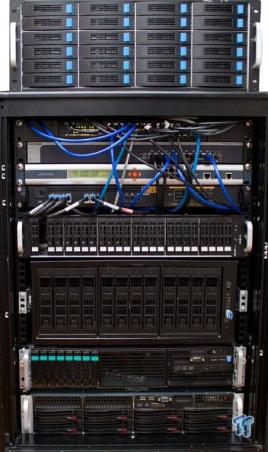

Our approach to storage testing targets long-term performance with a high level of granularity. Many testing methods record peak and average measurements during the test period. These average values give a basic understanding of performance, but fall short in providing the clearest view possible of I/O QoS (Quality of Service).
While under load, all storage solutions deliver variable levels of performance. "Average" results do little to indicate performance variability experienced during actual deployment. The degree of variability is especially pertinent, as many applications can hang or lag as they wait for I/O requests to complete. While this fluctuation is normal, the degree of variability is what separates enterprise storage solutions from typical client-side hardware.
Providing ongoing measurements from our workloads with one-second reporting intervals illustrates product differentiation in relation to I/O QoS. Scatter charts give readers a basic understanding of I/O latency distribution, without directly observing numerous graphs. This testing methodology illustrates performance variability, and includes average measurements during the measurement window.
IOPS data that ignores latency is useless. Consistent latency is the goal of every storage solution, and measurements such as Maximum Latency only illuminate the single longest I/O received during testing. This can be misleading, as a single "outlying I/O" can skew the view of an otherwise superb solution. Standard Deviation measurements consider latency distribution, but do not always effectively illustrate I/O distribution with enough granularity to provide a clear picture of system performance. We utilize high-granularity I/O latency charts to illuminate performance during our test runs.
We conduct our tests over the full LBA range to allow each HDD to highlight its average performance. The WD Red Pro spins at 7,200 RPM, and will offer higher performance for heavier workloads, and we include it as a reference point for a high-performance RAID alternative. The other drives in the test pool have a 5,400-RPM spindle speed. The 4TB Red in our test pool features previous-generation NASware 2.0, and the 6TB drive features NASware 3.0. The first page of results will provide the "key" to understanding and interpreting our test methodology.
Benchmarks - 4k Random Read/Write
4k Random Read/Write
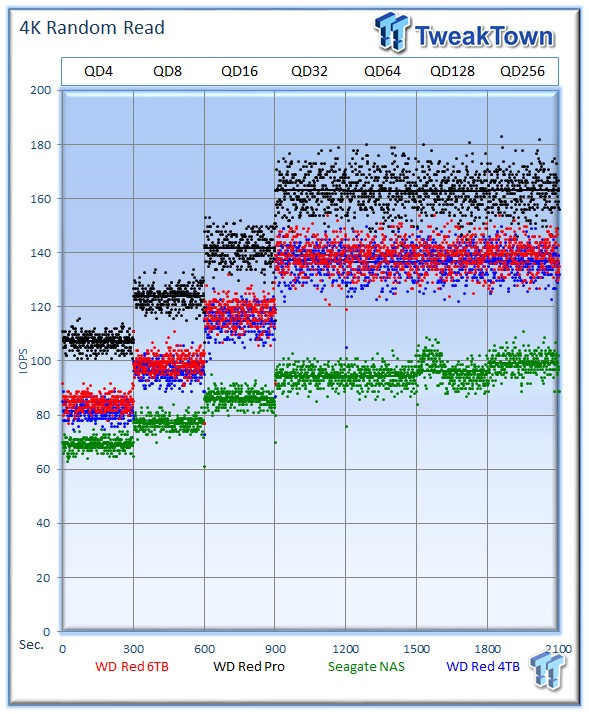
Each level tested includes 300 data points (five minutes of one second reports) to illustrate performance variability. The line for each queue depth represents the average speed reported during the five-minute interval. 4K random speed measurements are an important metric when comparing drive performance, as the hardest type of file access for any storage solution to master is small-file random. 4K random performance is a heavily marketed figure, and one of the most sought-after performance specifications.
It is important to note that the 6TB Red features NASware 3.0, and the 4TB Red utilizes previous-generation NASware 2.0. The 6TB Red squeezes by the 4TB version with an average of 139 IOPS at QD256. The WD Red Pro leads the chart with 163 IOPS at QD256, the original 4TB WD Red scores 136 IOPS, and the Seagate NAS HDD provides 99 IOPS.

The two Red drives are very close in latency performance during the measurement window.

The 6TB WD Red averages 146 IOPS at QD256, the WD Red Pro averages 192 IOPS, the 4TB WD Red provides 147 IOPS, and the Seagate NAS HDD provides 116 IOPS at QD256. The increased speed of the 7,200 RPM WD Red Pro is apparent in heavy random workloads, and the two client-oriented Red's continue to operate within very similar performance envelopes.

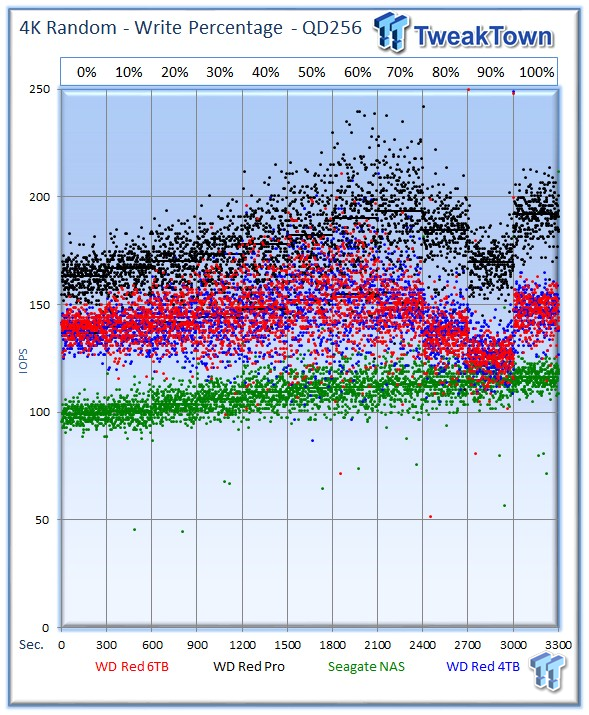
Our write percentage testing illustrates the varying performance of each solution with mixed workloads. The 100% column to the right is a pure write workload of the 4k file size, and 0% represents a pure 4k read workload.
The 4TB and 6TB Reds continue to provide faster performance than the other 5,400-RPM NAS HDD in the test pool.

We record power consumption measurements during our test run at QD256. It is important to note the difference in RPM between the WD Red Pro at 7,200 RPM, in comparison to the lower RPMs featured in the 4TB and 6TB WD Reds and the Seagate NAS HDD. The higher-RPM drive will predictably feature higher power consumption.
The 6TB Red requires an amazingly miserly 5.13 watts, while the WD Red Pro draws 10.26 watts, the 4TB WD Red averages 5.48 watts, and the Seagate NAS HDD requires 5.63 watts.


We generate IOPS-to-watts measurements from data recorded during the test period. The 6TB WD Red provides 28 IOPS-per-watt during the write workload and 21 IOPS-per-watt during the read workload. The client-oriented Reds are amazingly efficient in this workload.
Benchmarks - 8k Random Read/Write
8k Random Read/Write

Server workloads rely heavily upon 8k performance, and we include this as a standard with each evaluation. Many of our server workloads also test 8k performance with various mixed read/write workloads.
The average 8k random read speed of the 6TB WD Red is 138 IOPS at QD256, while the WD Red Pro is 162 IOPS, the 4TB WD Red offers 135 IOPS, and the Seagate NAS HDD provides 92 IOPS.

The latency gap between the WD products shrinks with 8k random workloads, while the Seagate NAS HDD continues to lag behind.

The 6TB Red averages 143 IOPS at QD256, the WD Red Pro averages 193 IOPS, the 4TB WD Red provides 146 IOPS, and the Seagate NAS HDD averages 116 IOPS.


The 4TB and 6TB Reds continue to offer very similar performance.

Power consumption for the 6TB WD Red Pro is again very impressive at 5.52 watts.

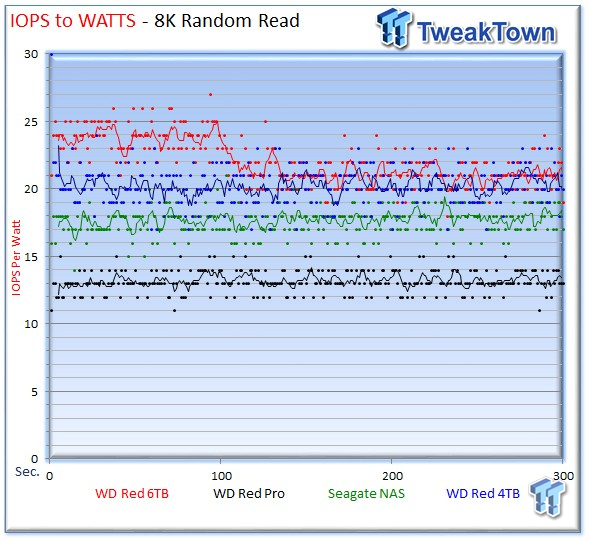
The 6TB WD Red averages 26 IOPS-per-watt during write activity, and leads again with an average of 22 IOPS-per-watt during the read workload.
Benchmarks - 128k Sequential Read/Write
128k Sequential Read/Write

We write to every LBA to highlight performance degradation from the outer to inner tracks of the drive. The drives begin with much higher speed on the outer tracks, and lose speed as it works inward. It required 7.5 hours to write the entirety of the capacity of the 4TB WD Red Pro drive, and 13.5 hours for the 6TB Red. A sequential read test following the same methodology results in nearly identical results.

128k sequential speed reflects the maximum sequential throughput of the SSD, and is indicative of performance in OLAP, batch processing, streaming, content delivery applications, and backup scenarios. Today's HDDs are increasingly used for sequential workloads as SSDs encroach upon the application space.
The WD Red Pro leads the test with 171 MB/s at QD256, but the 6TB Red is close on its heels with an average of 162 MB/s. The 4TB WD Red offers the lowest sequential read speed with 139 MB/s; the Seagate NAS HDD provides a staggered performance profile with an average of 163 MB/s at QD256.

The WD Red Pro offers the best overall latency during heavier workloads, but under light workloads, the 6TB Red is incredibly competitive with its 7,200-RPM counterpart.

Sequential write performance is important in tasks such as caching, replication, HPC, and database logging. The WD Red Pro provides a leading 170 MB/s at QD256, but once again, the 6TB Red isn't far behind with its average of 162 MB/s. The 4TB WD Red provides 139 MB/s, and the Seagate NAS HDD provides 162 MB/s.


The 6TB WD Red handily outperforms the 4TB version in mixed sequential workloads.

The 6TB WD Red averages 5.82 watts.


The 6TB WD Red offers 27 MB/s for read, and 27 write MB/s-per-watt.
Benchmarks - Database/OLTP and File Server
Database/OLTP

This test consists of Database and On-Line Transaction Processing (OLTP) workloads. OLTP is the processing of transactions such as credit cards and high frequency trading in the financial sector. Databases are the bread and butter of many enterprise deployments. These demanding 8k random workloads with a 66 percent read and 33 percent write distribution bring even the best solutions down to earth.
The 6TB WD Red averages 145 IOPS at QD 256, the WD Red Pro provides 173 IOPS, the 4TB WD Red averages 144 IOPS, and the Seagate NAS HDD provides 99 IOPS.


The 6TB WD Red requires an average of 5.56 watts during the workload.

The 6TB WD Red provides 22 IOPS-per-watt.
File Server

The file server profile consists of typical file server workloads. This profile tests a wide variety of different file sizes simultaneously, with an 80% read and 20% write distribution.
The 6TB Red doesn't score as well in the file server testing as it does with other tests, but still averages 133 IOPS. The WD Red pro offers 159 IOPS, while the 4TB WD Red offers an outstanding 182 IOPS, and the Seagate NAS HDD provides 118 IOPS.


The 6TB WD Red averages 5.54 watts during the fileserver workload.

The 6TB WD Red offers 21 IOPS-per-watt during the measurement window.
Benchmarks - Email Server
Email Server

The email server workload is a demanding 8K test with a 50% read and 50% write distribution. This application is indicative of the performance in heavy write workloads.
The 6TB WD Red provides 150 IOPS at QD256, and the WD Red Pro provides an average of 182 IOPS at QD256. The 4TB WD Red delivers 151 IOPS, and the Seagate NAS HDD provides 151 IOPS.


The 6TB WD Red averages 5.46 watts during the email server workload.

The 6TB WD Red offers 24 IOPS-per-watt during the measurement window.
Final Thoughts

WD experienced tremendous success when they pioneered the client NAS HDD segment with the popular WD Red series. The Red series addresses DAS RAID users as well, providing a value option for smaller RAID arrays that was not present a few short years ago. Professional users with RAID controllers, and even those with large onboard RAID arrays, have flocked to the Red series for its compelling mix of performance and value. Other HDD manufacturers have entered the client-NAS segment, but have not been able to deliver solutions that are as competitive in as many performance metrics.
WD has expanded upon their leading performance on two fronts with the new line of WD Reds. First, they increased the bay count from one to five bay applications up to eight bays via the benefits of NASware 3.0 firmware enhancements. This allows the Red to address even larger arrays with the same great value, high performance, and low power consumption. WD's success with the Red series also prompted the release of the WD Red Pro, which broadens the series out to eight to sixteen bay applications with a faster 7,200-RPM spindle speed.
We included the WD Red Pro in our results to highlight the higher performance of a leading 7,200-PRM HDD. While the WD Red Pro leads performance across the board, it also highlights the increase in power consumption experienced when moving to 7,200-RPM HDDs. One of the most impressive features of the 6TB WD Red is its miserly power consumption. Drives that feature low power consumption often feature lower performance, which adversely affects IOPS-per-Watt efficiency. The 6TB Red manages to pull off the lowest power consumption, and best efficiency metrics of our test pool, unseating the Seagate NAS HDD from its role as the HDD with the lowest power consumption.
Another area the Seagate NAS HDD previously had a big advantage was in sequential performance. The 6TB Red also unseated the Seagate NAS HDD's lead in sequential performance measurements with an impressive increase over the previous generation 4TB capacity point. The improved sequential performance is rather impressive from a 5,400-RPM drive, and even approaches the speed offered by the faster Red Pro offering.
The random performance of the 6TB WD Red remained on par, or slightly above the performance offered by the previous-gen 4TB WD Red. The 6TB Red managed to best all other client-NAS specific HDDs in the majority of the workloads, with the notable exception of the fileserver workload. The 6TB Red fell behind the 4TB variant in this workload, but managed to keep a healthy lead over the Seagate NAS HDD. Power consumption remained incredibly good during our random testing.
Previously, users with RAID controllers and large onboard RAID arrays had to choose between risking the use of desktop HDDs, or purchasing high-performance datacenter-class drives that also feature a big price tag. The WD Red offers a great compromise that provides increased performance with RAID-specific reliability features, and all within an impressively low power envelope. The WD Red series also commits all outstanding commands to the platters during power loss - a notable feature for those utilizing RAID controllers. The three-year warranty and workload rating of 180TB a year are complemented by a 24/7 premium support line and broad compatibility, winning the WD Red series with NASware 3.0 the TweakTown Editor's Choice award for the one to eight bay NAS/RAID segment.
PRICING: You can find the WD Red Enterprise HDD for sale below. The prices listed are valid at the time of writing, but can change at any time. Click the link to see the very latest pricing for the best deal.
United States: The WD Red 6TB retails for $292.00 at Amazon, the WD Red 5TB retails for $244.00 at Amazon, the WD Red 4TB retails for $169.00 at Amazon, the WD Red 3TB retails for $121.99 at Amazon, the WD Red 2TB retails for $98.00 at Amazon, and the WD Red 1TB retails for $65.29 at Amazon.
Canada: The WD Red 6TB retails for CDN$375.48 at Amazon Canada, the WD Red 5TB retails for CDN$312.37 at Amazon Canada, the WD Red 4TB retails for CDN$203.16 at Amazon Canada, the WD Red 3TB retails for CDN$139.98 at Amazon Canada, the WD Red 2TB retails for CDN$119.99 at Amazon Canada, and the WD Red 1TB retails for CDN$74.98 at Amazon Canada.

| Performance | 95% |
| Quality, Design, Build and Warranty | 95% |
| General Features | 93% |
| Performance Consistency | 93% |
| Power Consumption and Efficiency | 97% |
| Overall | 95% |
The Bottom Line: It's not easy to improve upon a leading mix of high performance and low power consumption, but the 6TB WD Red offers significant improvements and more capacity for NAS and DAS RAID users at an exceptional price point.
PRICING: You can find products similar to this one for sale below.
 United
States: Find other tech and computer products like this
over at Amazon.com
United
States: Find other tech and computer products like this
over at Amazon.com
 United
Kingdom: Find other tech and computer products like this
over at Amazon.co.uk
United
Kingdom: Find other tech and computer products like this
over at Amazon.co.uk
 Australia:
Find other tech and computer products like this over at Amazon.com.au
Australia:
Find other tech and computer products like this over at Amazon.com.au
 Canada:
Find other tech and computer products like this over at Amazon.ca
Canada:
Find other tech and computer products like this over at Amazon.ca
 Deutschland:
Finde andere Technik- und Computerprodukte wie dieses auf Amazon.de
Deutschland:
Finde andere Technik- und Computerprodukte wie dieses auf Amazon.de
Related Tags
